True Audio, 387 Duncan Lane, Andersonville, Tennessee 37705; Phone/Fax: 423-494-3388; http://www.trueaudio.com; WinSpeakerz Speaker Design Software: $129.00 US; “Introduction to Loudspeaker Design”: $24.95 US; 166 pp
(If you would like to have your DIY project published in Secrets, please E-Mail Ralph Calabria at [email protected].)
Introduction
Aren’t computers great? As we close the 20th century, it’s hard to imagine
going through a typical day without one.
Sending and receiving e-mail from all over the world, searching
the Internet, sending FAX messages, not to mention the thousands
of other software programs available (O.K. I’ll mention a
few) like word processing, scheduling and project organization,
and the slew of 3D games on the market.
Suffice it to say, the computer is not just a glorified
typewriter anymore!
Many things that were done using tedious, repetitive calculations (on a hand-held calculator) can now be glorified using Excel spreadsheets. The same holds true for a variety of other tasks that took much longer before the computer emerged to its current status. Take loudspeaker design, for example. Hand calculations using the formulas originating from Thiele and Small took quite a bit of time to crank out and plot on a graph (also by hand, point, by point, by point) to get a response curve. Now there are several CAD (Computer Aided Design) programs on the market that use these formulas to calculate AND plot a frequency response curve. One such piece of software is True Audio’s WinSpeakerz: The Speaker Design Toolbox, by John L. Murphy. And what better way to augment loudspeaker design software than with a book that teaches you about the basics of loudspeaker design. As coincidence would have it, Mr. Murphy has also written a book entitled “Introduction to Loudspeaker Design”, a tutorial of sorts, with an intention to supplement the information included in the WinSpeakerz user’s manual.
WinSpeakerz:
The Speaker Design Toolbox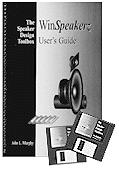
Like all loudspeaker design software, WinSpeakerz uses formulas to calculate a response curve for a given driver based on the Thiele/Small (T/S) parameters of the driver. So, in order for WinSpeakerz to do its thing, you’ll need to have the T/S parameters handy to load into the program. (There is also a very large driver database that is included with the software.) The program’s System Editor supplies the user with space to completely file your driver system info. In addition to the T/S parameters, useful information such as the physical and mounting specifics, driver materials of construction, and picking an enclosure response for the system (including baffle diffraction loss and automotive applications) can be stored as part of the system ‘package’.
O.K., so now you’ve put all the
T/S parameters into the program; now what?
Well, the rest is pretty intuitive, and the user’s
manual guides you through all the options you have to choose from.
Let’s take a look at some of the more useful ones.
WinSpeakerz can calculate box volumes for the following systems: 2nd and 3rd order closed box, 4th
order vented box, and 4th, 5th, and 6th
symmetric bandpass alignments.
Besides plotting frequency response, WinSpeakerz can also
plot Phase, Group Delay, Impedance, and Excursion responses.
To best illustrate what this program can do, let’s
use the example of Dayton’s Titanic 12” subwoofer driver.
This driver looks great on paper, with excellent power
handling and a decent Xmax (maximum
excursion of the voice coil front to back). Let’s
plug it into WinSpeakerz and see what happens!
Figure 1A is a snapshot of the screen once the driver is
loaded into the program. You’ll notice that on the x-axis is the
frequency (Hz) and on the y-axis is dB.
At the bottom left is displayed driver and system parameters,
and on the bottom right is the alignment we've selected
(in this case, a 2nd order closed box).
FIGURE 1A: WinSpeakerz default screen with Titanic driver loaded
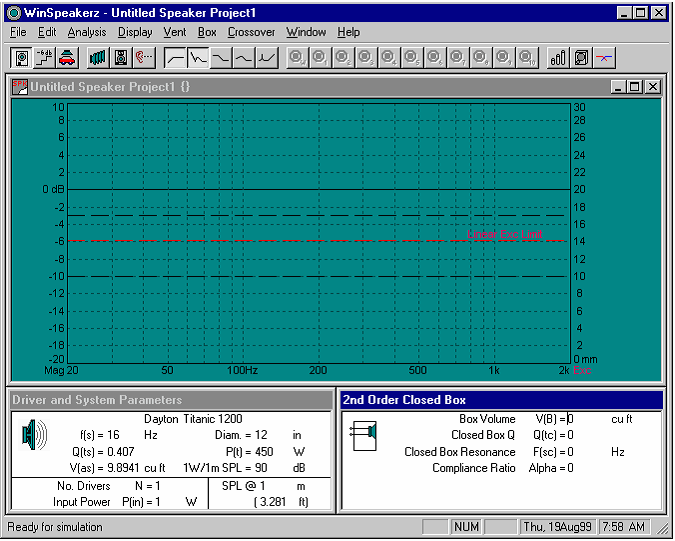
To get various alignments for this driver, WinSpeakerz
takes some of the guess work out of . . . well . . . guessing.
By keeping the box volume set at 0 and asking the program
to calculate the frequency response, WinSpeakerz will supply you
with 10 different alignments, while storing them in memory.
By selecting or de-selecting each plot using the store
buttons on the top tool bar, one can view each alignment individually
and determine which alignment is best.
Figure 1B shows you what to expect when asking WinSpeakerz
for suggestions
FIGURE 1B: Array of responses suggested by WinSpeakerz
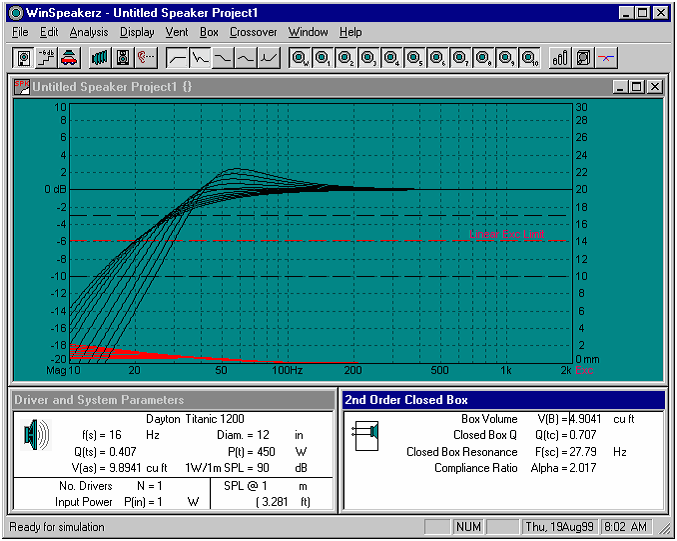
You’ll notice that some of the suggested alignments
can be eliminated because of a sharp peak in the frequency response,
while others may be eliminated because bass extension is weak.
The main point here is, YOU can pick the alignment that
works best for your design, fully aware of the tradeoffs involved
before making the speaker enclosure.
OK, back to our subwoofer design.
After doing some weeding, we come up with a couple of alignments
that look good in terms of frequency response vs. ripple peaks.
Figure 2 summarizes the two best alignments WinSpeakerz
came up with.
FIGURE 2:
Best calculated responses from array
|
System # |
|
|
|
System Q (Qts) |
|
|
|
F3
(Hz) |
|
|
|
F6
(Hz) |
|
|
|
Box volume (cu.ft.) |
|
|
|
Ripple (dB) |
|
|
By changing the system Q, the box volume changes
dramatically at the expense of a small ripple at 70 Hz.
You, as the designer, choose the tradeoffs.
As it turns out, by adding acoustical stuffing to system
#1, the small peak may be tamed to a great extent, if not eliminated
completely. However,
man does not live by frequency response alone.
There are several other things to consider to ensure your
design is successful.
Excursion Response
How loud will the design play, and how much power
can the system handle before it crashes and burns? These are good questions to ask yourself (particularly
the latter). Well,
WinSpeakerz can help you answer them.
First, let’s explain excursion.
Excursion is a term used to describe the movement of the
driver cone back and forth.
The maximum allowable movement of the cone before distortion
occurs is the Xmax. This translates to a distance the voice coil
can move within the magnet assembly without popping out.
This relationship is usually given in millimeters for the
distance traveled in one direction, say 10mm.
If the Xmax is exceeded, you will usually hear
distortion and occasionally a popping sound coming from the speaker.
Should this happen, turn down the volume, as this may cause
damage to the speaker.
The excursion of the speaker system is related to
the box design, and the power fed to the speaker.
In Figure 3, you’ll see that the driver and system parameters
window gives you the option to select multiple drivers and/or
the input power used. By
plugging in a power number, then calculating the frequency response,
excursion data is also generated.
The more power used, the higher the excursion response
becomes. For system
#1, WinSpeakerz tells us that the maximum power handling is 170
watts, after which the excursion limit of the driver is exceeded.
FIGURE 3: Excursion plot vs. power and dB output
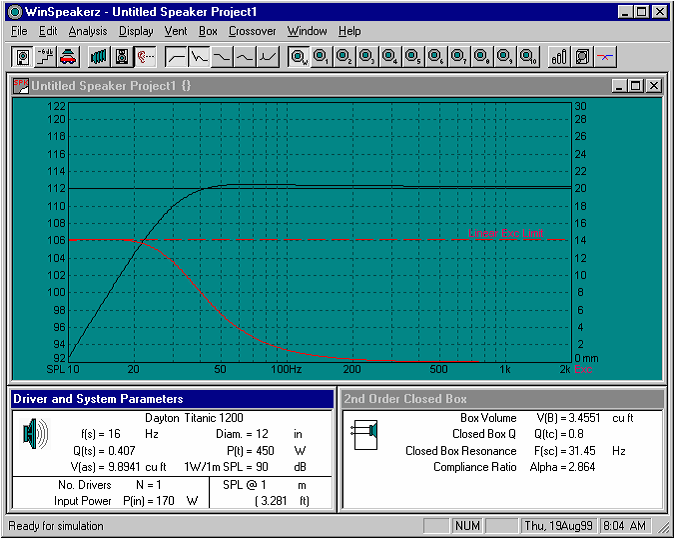
Along with the excursion data, comes system SPL,
or how loud the system will play at a given power input. WinSpeakerz can toggle between a dB plot and a dB SPL plot. The
dB SPL plot displays how loudly the system will play at a given
frequency and power input.
Figure 3 shows that system #1 will play at 112.5 dB through 52 Hz, then drop off sharply as frequency is decreased (note the
excursion plot is in red). This system has the capability of playing
at 104.5 dB at 20 Hz. Not
too shabby! As a
side note, system #2 can only handle 110 watts before reaching
the excursion limit of the driver, and will play at 110.5 dB at
52 Hz.
Group Delay Response
The time delay experienced by the audio signal between
the speaker’s electrical input terminals and the acoustic
output is known as the group delay.
What does this mean?
Well, if the group delay is large enough, it will be audible.
The audible threshold for group delay is about 30 milliseconds,
although lower is desirable.
WinSpeakerz calculates group delay to let you know
if your design is within the desired range. See Figure 4 for
the Titanic system group delay (blue plot).
As you can see, our example has a maximum group delay at
23 Hz of 9.2 milliseconds.
Phase Response
The difference in phase between the input of the
speaker and the speaker’s output is known as the phase response
of the system. The
phase response of a system should produce a smooth curve with
not much in the way of large humps.
This would indicate that the group delay is large, approaching
the audible limit. Again
for our example, the response is smooth, as would be expected
by the system’s low group delay (Figure 4, purple line).
Impedance Response
Calculating impedance for your system is important to ensure the impedance does not drop too low. Knowing the minimum impedance of a system will guarantee you won’t run into amplifier problems at the impedance minima. For a closed box system, one sees a sharp increase in impedance at the resonance frequency of the box (in the example of the Titanic, about 75 ohms at 31.5 Hz). The impedance minima is about 5 ohms for system #1 (see Figure 4; yellow line). WinSpeakerz is also equipped with an Impedance Compensator calculation, which may be use in the crossover of a system to smooth out the impedance curve.
FIGURE 4: Group delay, Phase, and Impedance Responses
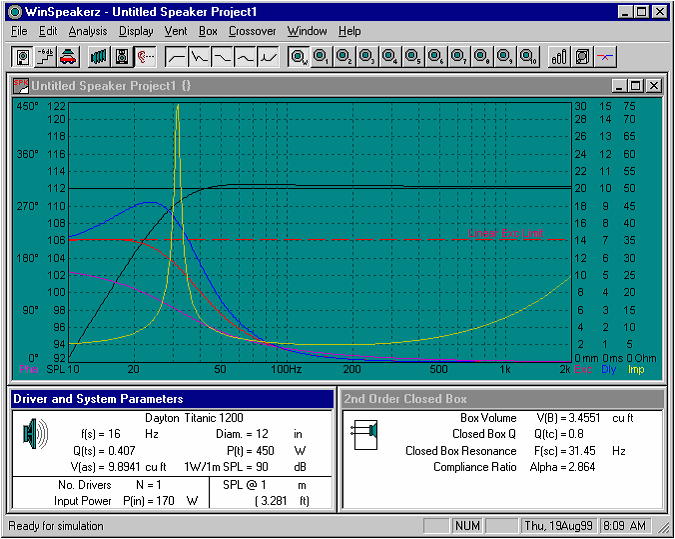
Crossover Design
WinSpeakerz has the capability to calculate a variety
of crossover networks including 1st, 2nd,
and 3rd order Butterworth, 1st order Series,
and 2nd and 4th order Linkwitz-Reilly.
As mentioned before, there is an impedance compensator
as well as a tweeter attenuation calculation and a resonance compensator.
As in all loudspeaker designs, these crossover calculators
are a very good starting point.
To fine tune a crossover to get the response just right
may take some tweaking.
This tweaking usually requires equipment that actually
measures the frequency response of the speaker system.
Various Other Goodies
Aside from the above mentioned functions, WinSpeakerz can model
diffraction loss, as well as auto-cabin response for those who
are looking to get into the hi-end car stereo business.
For vented (ported) systems, WinSpeakerz has a vent calculator that
summarizes the size, length, and number of vents needed for a given
system. There is
also a box calculator for rectangular, trapezoidal, and bandpass
enclosures, which gives you the option of ‘freezing’
a dimension (length, width, or height), and WinSpeakerz calculates
the remaining dimensions.
Also provided in the box calculator are displacement compensation
for driver, bracing, and other displacements, and acoustical fill
compensation which calculates V(b) increase due to filling.
I’ve touched on the major strong points the
program can do. There
are many more that allow you to play with data once compiled,
save systems for future work, and input your own drivers into
the already 1080 driver database that comes with the software.
Summary
In short, WinSpeakerz is a great piece of speaker
modeling software that can be used by both the novice and experienced
designer. The combination
of its pull-down menus and user’s manual make this
package a breeze to use; very easy, very intuitive, very nice (for all you Macintosh users out there, True Audio also offers
an all-new version of MacSpeakerz). There’s a lot of speaker modeling software
out there to choose from.
If you’re in the market to design and build your own
speakers, take a look at this one. It’s got all the features you need to
get you started. And
unless you’ve got enough dough to plunk down on state of
the art LEAP and LMS design system software, this package is a
bargain at $129 US. In
fact, if you order WinSpeakerz and mention this Secrets article, True
Audio will honor a discounted price of $116.10 US (10% off).
" 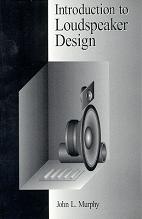 Introduction to Loudspeaker Design"
Introduction to Loudspeaker Design"
What better way to learn the art of speaker design
than to read books on the subject?
But which books should you read?
Are some really good?
Which ones are worth reading, and ultimately keeping for
your reference library?
For years, the “bible” for loudspeaker design
has been Vance Dickason’s “The Loudspeaker Design Cookbook”,
a classic in its own right with lots of information, graphs, theory,
and application. This
book is a must have for anyone serious about learning about loudspeaker
design. But to some,
particularly the novice, this book may be a bit advanced.
John Murphy has written a book entitled “Introduction
to Loudspeaker Design” (ILD).
As the title indicates, the author takes a very basic approach
to understanding the loudspeaker as a whole system, the sum of
its parts, if you will.
He then takes us through the various loudspeaker enclosure
types, including closed box, vented box, and 4th, 5th,
and 6th bandpass systems. The book really does a good job of complimenting
the material supplied with the WinSpeakerz user’s manual.
It essentially picks up where the WinSpeakerz user’s
manual leaves off. Terms
like group delay, phase, impedance, and excursion (remember these
for WinSpeakerz?) are explained in greater detail.
I think one of the main strengths of this book is the way
Mr. Murphy approaches the topics.
He explains things clearly and concisely.
After reading this book, you walk away really feeling like
you’ve learned something about loudspeaker design.
“ILD” is a book that is worth making room for
on your reference book shelf.
Since owning this book, I’ve come back to it many
times (and no, it’s not because I have a lousy memory).
In learning about loudspeaker design, one of the first things that is apparent is that there are tradeoffs to every design. “ILD” discusses these tradeoffs as they pertain to bandwidth, enclosure size, and sensitivity. There is also a chapter that describes frequency and pitch and how it relates to the audible frequency range and ultimately, loudspeaker design. Sound Pressure Level (SPL) is also discussed with respect to speaker sensitivity and distance.
There are 7 chapters and 3 Appendices in the book.
Here are the chapter titles for reference:
- Chapter 1:
Audio Basics
- Chapter 2:
Loudspeaker Basics
- Chapter 3:
Advanced Loudspeaker Topics
- Chapter 4:
Enclosure Design and Construction
- Chapter 5:
Crossover Design
- Chapter 6:
Driver Parameter Measurements
- Chapter 7:
Frequently Asked Questions
- Appendix A:
Technical References
- Appendix B:
Loudspeaker Design Aids
- Appendix C:
Box Types
While Chapter 1 gets your feet wet on the audio
subject, Chapter 2 begins you on the road to loudspeaker design,
starting with the very basics such as the components that comprise
a loudspeaker and the anatomy of a driver.
Once taken through the various loudspeaker enclosure types,
response curve goals are outlined with respect to phase, frequency,
delay, excursion, and impedance.
Thiele-Small parameters are also explained.
Chapter 3 dives into more involved topics such as
spacial loading, diffraction loss, cavity effect, enclosure losses,
and point, line, and plane sources. Even with some of these more advance topics,
Mr. Murphy explains each concept (with the help of some nice graphics
and basic equations) in a way that is easily understood and retained.
Not much time is spent on the carpentry aspects of enclosure design and construction
(Chapter 4), but this part of loudspeaker design can be found
at various sites (including the DIY section of Secrets) on the
Internet. Two very
useful tables are provided which use a standard rule of thumb
when calculating box dimensions with respect to length, width,
and height.
Crossover design (Chapter 5) covers a few of those
frequently asked questions you’ve always wanted answered
like: “What
problems will I run into when designing a crossover network, and
how can I get around them?”
Several types of crossovers are described which also include
driver impedance, resonance, and inductance compensation, and
tweeter attenuation. Note
that formulas are not given to calculate any crossovers. However,
WinSpeakers is equipped to calculate all topics described in this book, and
there are other software programs for calculating crossover component values
(for achieving low-pass and high-pass frequencies).
Serious speaker builders/designers are inclined
to measure their drivers before loading them into any software
program. This is
because a driver’s T/S parameters may vary from lot-to-lot
from the speaker manufacturer.
Some of the deviations may not be large enough to have
an effect on the design, however, it’s a good idea, when
designing speaker pairs, that the drivers used in both speakers
have T/S parameters that are the same (or at least very close).
Chapter 6 discusses hardware requirements, and how to measure
a driver’s free air resonance (Fs), total Q (Qts), mechanical
Q (Qms), electrical Q (Qes), and equivalent volume (Vas).
The chapter that contains FAQs addresses concerns
related to topics such as the correct way to port a vented enclosure,
summing the phase response of a multi-speaker system, and the
proper way to mount and align drivers in a baffle (just to name
a few).
“Introduction
to Loudspeaker Design” gives the reader an excellent fundamental
understanding of the topic. The author’s approach to explaining things creates a learning environment that makes it easy to
grasp sometimes-intense concepts.
I would recommend this book to anyone who is interested
in speaker design. It’s
clearly not a replacement for Dickason’s work, but was never
meant to be. However,
this book is an excellent supplement to the “Cookbook”,
and certainly compliments the user’s manual for True Audio’s
WinSpeakerz speaker design software.
As for the software, mention this review and receive 10% off the list price.
That’s $22.45 US (hey, that beats Amazon!). This discount
is valid through January 31, 2001.
Glossary
of Terms
For clarification, here are some basic definitions of terms that are mentioned in the article. These are the more important parameters needed to design a loudspeaker. A much detailed explanation of these terms can be found in �Introduction to Loudspeaker Design�. There are many other driver parameters that I have not mentioned here, that can be found either in ILD or �The Cookbook�.
Vas: Expressed in cubic feet or liters, this is the volume of air having the same acoustic compliance as the driver suspension. In other words, (and I take this straight from John�s book), the volume of air which would be as stiff as the suspension of the driver when compressed by a piston the same size as the driver�s cone.
fs: The resonance frequency of the driver. The free air resonance of the driver when not in an enclosure (hence, free air).
Q: The ratio of reactance to resistance in a series circuit, or the ratio of resistance to reactance in a parallel circuit.
Qts: The total Q of the driver at fs, considering all driver resistances. This is calculated from the electrical Q (Qes) and the mechanical Q (Qms) of the driver.
- Ralph Calabria -
Return to Table of Contents for this Issue.

